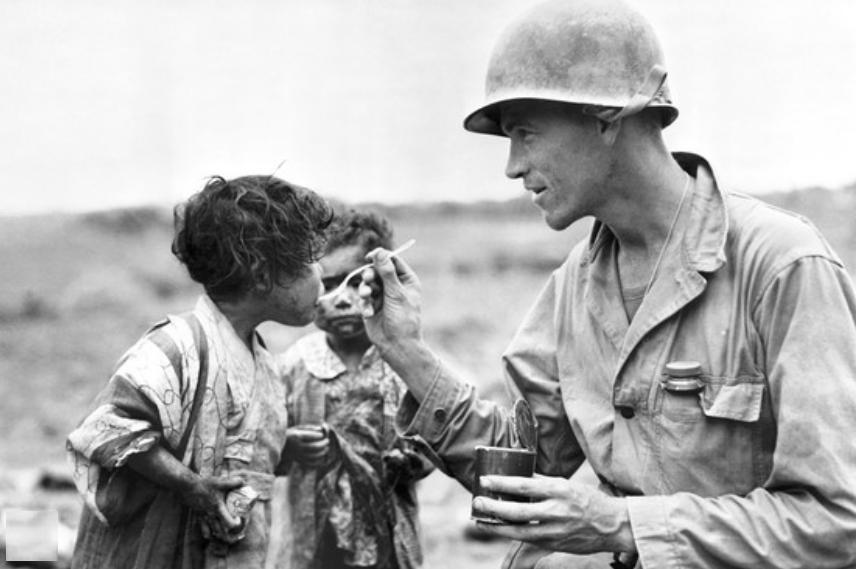
World War II Pacific Theater: Okinawa--Relief Efforts

Figure 1.--Here an American GI shares is C-rations with some Okinawan children. This looks to be away fom the front line or in the northern section of the islnd where the Japanese resistnc waa more limited than in the south. We are not sure if the children are prphans are just seeking food from American GIs. Notice how they are fully at easy with the soldier. Unfortunately we do not have the associated Signal Corps caption. Source: U.S. Army Signal Corps.
|
|
The Japanese military made little or no effort to aid civilians. In fact they victimized civilians, such as seizing food from them. Some civilians were even executed for hiding food. There were various reasons for this. First they looked down on the Okinawans for racial reasons. Second, supplies were short even before the invasion and after the invasion supplies ran out. Third, there were many inv\cidents of soldiers raping Okimawan women.
Four, the Japanese used civilians as human shields. Fifth, civilians were mobilized to aid the miltary. This was part of the Ketsugo Doctrine that Japanese children were being taught on the Home Islands, ary believed that the civilians as well as soldirs should commit suicide and not allowed themselvs to fall into American hands. Not all Japanese soldiers did this, but many if not most did. In numerous cases, those civilians unwilling to do so were actually killed by the soldiers. The U.S. military, in sharp contrast made considerable effort to save the civilians. Individual American soldiers shared their rations with civilians. The children were the first to discover that American soldiers could be soft touches. Camps were set up behind the front line to povide shelter, water, food, and medical treatment. The surviving civilian having been convinced by the Japanese military that they would be victimized and suffer terrible torture if they fell into Americans hands were according to one historian "... often surprised at the comparatively humane treatment they received from the American enemy." [Molasky, p. 16.] Another historian writes that the Americans "did not pursue a policy of torture, rape, and murder of civilians as Japanese military officials had warned." [Selden, p. 18.] U.S. Military Intelligence Corps aware of what had happened on Saipan prepared leaflets to drop in areaswhere civilians would finf them. Combat translators such as Teruto Tsubota also took the initiative in convincing many civilians not to commit suiside. ['Defiant'] ventually cuvilians began to mseek out the Americans and make their way to camps where they could be aided. The boy and elderly man on the previous page are examples of the survivors, many in dreadful shape.
Sources
Molasky, Michael S. The American Occupation of Japan and Okinawa: Literature and Memory (Routledge: 1999).
Selden, Mark in Laura Elizabeth Hein and Mark Selden, ed. Islands of Discontent: Okinawan Responses to Japanese and American Power.
'Defiant soldier saved lives of hundreds of civilians during Okinawa battle,' Stars and Stripes (April 1, 2005).
CIH

Navigate the CIH World War II Pages:
[Return to Main Okinawan civilian page]
[Return to Main Okinawa page]
[Return to Main World War II: American POW page]
[Return to Main World War II Pacific campaign page]
[Return to Main Japanese World War II attrocities page]
[Return to Main World War II page]
[Biographies]
[Campaigns]
[Children]
[Countries]
[Deciding factors]
[Diplomacy]
[Geo-political crisis]
[Economics]
[Home front]
[Intelligence]
[POWs]
[Resistance]
[Race]
[Refugees]
[Technology]
[Totalitarian powers]
[Bibliographies]
[Contributions]
[FAQs]
[Images]
[Links]
[Registration]
[Tools]
[Return to Main World War II page]
[Return to Main war essay page]
[Return to CIH Home page]
Created: 7:10 PM 5/8/2015
Last updated: 10:29 AM 4/16/2019



